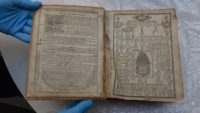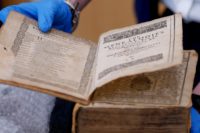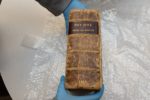 A 404-year-old Bible that was stolen from the Carnegie Library of Pittsburgh in the 1990s has been returned after being found in a museum in the Netherlands.
A 404-year-old Bible that was stolen from the Carnegie Library of Pittsburgh in the 1990s has been returned after being found in a museum in the Netherlands.
“After being identified as stolen, officers from the Leiden Museum, along with the DA’s office here in Pittsburgh, the FBI in the Netherlands and the FBI in the Netherlands and the FBI art crime team arranged for the return of the Bible,” said [FBI agent Robert] Jones.
The theft was discovered many years after it happened, in April 2017 insurance audit of the library’s holdings. Auditors found out that 314 books were missing from the Oliver Room, the rare books room which can only be accessed by scholars and researchers by prior appointment. It is not and has never been open to the public. The value of the lost books and pages added up to an estimated $8 million.
An investigation revealed that the thefts had taken place over a period of two decades. It was an inside job, an obscenely cupidinous betrayal by Gregory Priore, the sole archivist for the Oliver Room’s collection who systematically removed entire books or pages with important maps or images, cut out with an X-acto knife, and walked them down the block to book seller John Schulman, co-owner of the Caliban Book Shop. Schlman would pay him up front and then sell the books and amputated pages at a profit. Because all the most effective hypocrites hide in plain sight, Schulman had once been the chairman of the ethics committee Antiquarian Booksellers’ Association of America. Priore was fired when the thefts were discovered. Last year Priore and Schulman were charged with multiple counts of theft, conspiracy and other crimes related to the scheme.
 The FBI Pittsburgh office has been looking for the 314 missing items and have so far recovered 18 books and 293 maps, plates and pamphlets. The 1615 Geneva Bible was traced to the American Pilgrim Museum in Leiden via the sale receipt from its 2015 acquisition by museum director Jeremy Dupertuis Bangs from a private seller for $1,200. Its estimated market value today is around $5,500, but Pittsburgh paid something in the neighborhood of $12,000 to get the Bible back from the museum safely.
The FBI Pittsburgh office has been looking for the 314 missing items and have so far recovered 18 books and 293 maps, plates and pamphlets. The 1615 Geneva Bible was traced to the American Pilgrim Museum in Leiden via the sale receipt from its 2015 acquisition by museum director Jeremy Dupertuis Bangs from a private seller for $1,200. Its estimated market value today is around $5,500, but Pittsburgh paid something in the neighborhood of $12,000 to get the Bible back from the museum safely.
The Pilgrims didn’t own this particular volume, as far as we know, but it was translated by English Protestant expatriates in Geneva during the reign of Catholic Queen Mary and a copy of this version of the Bible was known to have accompanied the pilgrims on the Mayflower. Bangs planned to display it at future exhibitions on books owned by the Pilgrims.
 The edition is also known as the Breeches Bible after an unusual translation of Genesis 3:7. Instead of the King James Version’s “And the eyes of them both were opened, and they knew that they were naked; and they sewed fig leaves together, and made themselves aprons,” in this version Adam and Eve go beyond the basic crotch-concealment of a fig leaf apron into full lower-body coverage. “Then the eyes of them both were opened, and they knewe that they were naked, and they sewed figtree leaves together, and made themselves breeches.”
The edition is also known as the Breeches Bible after an unusual translation of Genesis 3:7. Instead of the King James Version’s “And the eyes of them both were opened, and they knew that they were naked; and they sewed fig leaves together, and made themselves aprons,” in this version Adam and Eve go beyond the basic crotch-concealment of a fig leaf apron into full lower-body coverage. “Then the eyes of them both were opened, and they knewe that they were naked, and they sewed figtree leaves together, and made themselves breeches.”
Back in 93 I was doing map research dealing with colonial development in my college library. I turned in a list of atlases to the research desk that I needed. Next thing I know, the police are asking me questions-not one of the atlas I asked for was still in the library’s collection.
I was teaching a lesson on primary sources, some time latter, I asked my students to look up pictures of the atomic bomb damage in Japan from WWII. I had looked at the photos just four years before. They were gone, cut out of the periodical. It was a better example for my students than the actual photos would have been. It pissed them off a little bit as well-a good thing. Sadly, I could go on and on with examples of this sort.
In days of yore when super glue was unavailable, “breeches” makes better sense than a fig leaf. 😉
..Y..You use “superglue” to put on your pants?!? :ohnoes:
Actually, it reads φύλλα συκῆς, so I wonder what on earth you would do with a single(!) Fig Leaf. Particularly, ‘TRGH’ (to be read from right to left) might be correctly interpreted as ζῶματα or ‘Loincloths’, thus, we have ‘..καὶ ἐποίησαν ἑαυτοῗς περιζώματα’.
In proper Saxon, however, we speak of a ‘lenden-reáf’, in Old English of ‘ƿæd-‘ or ‘wæd-brec’, while in Greek, βράκαι (“brakai”) would be braccae, breeches, trews, or trousers. As in Puritanism it seems to be most essential to cover the buttocks also, a translation as ‘Bermuda shorts‘, or ‘Speedos’ would possibly be OK.
🌱🍁 👙⚠ ☣ 🐰
I assume the binding of the Bible is a later addition…? I have a Woods Natural History set (3 books) from 1850 that are almost the exact same binding.
@Susie –
Leather binding on raised bands was used in the 17th-century, so it is possibly original with the exception of the title panel. The wear to that is significantly less than the wear to the rest of the binding, so I expect that is a later addition (particularly as it includes the words “Breeches Edition, which is unlikely to have been on the original binding).